13.2: The Political Institution
- Page ID
- 3437
\( \newcommand{\vecs}[1]{\overset { \scriptstyle \rightharpoonup} {\mathbf{#1}} } \)
\( \newcommand{\vecd}[1]{\overset{-\!-\!\rightharpoonup}{\vphantom{a}\smash {#1}}} \)
\( \newcommand{\dsum}{\displaystyle\sum\limits} \)
\( \newcommand{\dint}{\displaystyle\int\limits} \)
\( \newcommand{\dlim}{\displaystyle\lim\limits} \)
\( \newcommand{\id}{\mathrm{id}}\) \( \newcommand{\Span}{\mathrm{span}}\)
( \newcommand{\kernel}{\mathrm{null}\,}\) \( \newcommand{\range}{\mathrm{range}\,}\)
\( \newcommand{\RealPart}{\mathrm{Re}}\) \( \newcommand{\ImaginaryPart}{\mathrm{Im}}\)
\( \newcommand{\Argument}{\mathrm{Arg}}\) \( \newcommand{\norm}[1]{\| #1 \|}\)
\( \newcommand{\inner}[2]{\langle #1, #2 \rangle}\)
\( \newcommand{\Span}{\mathrm{span}}\)
\( \newcommand{\id}{\mathrm{id}}\)
\( \newcommand{\Span}{\mathrm{span}}\)
\( \newcommand{\kernel}{\mathrm{null}\,}\)
\( \newcommand{\range}{\mathrm{range}\,}\)
\( \newcommand{\RealPart}{\mathrm{Re}}\)
\( \newcommand{\ImaginaryPart}{\mathrm{Im}}\)
\( \newcommand{\Argument}{\mathrm{Arg}}\)
\( \newcommand{\norm}[1]{\| #1 \|}\)
\( \newcommand{\inner}[2]{\langle #1, #2 \rangle}\)
\( \newcommand{\Span}{\mathrm{span}}\) \( \newcommand{\AA}{\unicode[.8,0]{x212B}}\)
\( \newcommand{\vectorA}[1]{\vec{#1}} % arrow\)
\( \newcommand{\vectorAt}[1]{\vec{\text{#1}}} % arrow\)
\( \newcommand{\vectorB}[1]{\overset { \scriptstyle \rightharpoonup} {\mathbf{#1}} } \)
\( \newcommand{\vectorC}[1]{\textbf{#1}} \)
\( \newcommand{\vectorD}[1]{\overrightarrow{#1}} \)
\( \newcommand{\vectorDt}[1]{\overrightarrow{\text{#1}}} \)
\( \newcommand{\vectE}[1]{\overset{-\!-\!\rightharpoonup}{\vphantom{a}\smash{\mathbf {#1}}}} \)
\( \newcommand{\vecs}[1]{\overset { \scriptstyle \rightharpoonup} {\mathbf{#1}} } \)
\( \newcommand{\vecd}[1]{\overset{-\!-\!\rightharpoonup}{\vphantom{a}\smash {#1}}} \)
\(\newcommand{\avec}{\mathbf a}\) \(\newcommand{\bvec}{\mathbf b}\) \(\newcommand{\cvec}{\mathbf c}\) \(\newcommand{\dvec}{\mathbf d}\) \(\newcommand{\dtil}{\widetilde{\mathbf d}}\) \(\newcommand{\evec}{\mathbf e}\) \(\newcommand{\fvec}{\mathbf f}\) \(\newcommand{\nvec}{\mathbf n}\) \(\newcommand{\pvec}{\mathbf p}\) \(\newcommand{\qvec}{\mathbf q}\) \(\newcommand{\svec}{\mathbf s}\) \(\newcommand{\tvec}{\mathbf t}\) \(\newcommand{\uvec}{\mathbf u}\) \(\newcommand{\vvec}{\mathbf v}\) \(\newcommand{\wvec}{\mathbf w}\) \(\newcommand{\xvec}{\mathbf x}\) \(\newcommand{\yvec}{\mathbf y}\) \(\newcommand{\zvec}{\mathbf z}\) \(\newcommand{\rvec}{\mathbf r}\) \(\newcommand{\mvec}{\mathbf m}\) \(\newcommand{\zerovec}{\mathbf 0}\) \(\newcommand{\onevec}{\mathbf 1}\) \(\newcommand{\real}{\mathbb R}\) \(\newcommand{\twovec}[2]{\left[\begin{array}{r}#1 \\ #2 \end{array}\right]}\) \(\newcommand{\ctwovec}[2]{\left[\begin{array}{c}#1 \\ #2 \end{array}\right]}\) \(\newcommand{\threevec}[3]{\left[\begin{array}{r}#1 \\ #2 \\ #3 \end{array}\right]}\) \(\newcommand{\cthreevec}[3]{\left[\begin{array}{c}#1 \\ #2 \\ #3 \end{array}\right]}\) \(\newcommand{\fourvec}[4]{\left[\begin{array}{r}#1 \\ #2 \\ #3 \\ #4 \end{array}\right]}\) \(\newcommand{\cfourvec}[4]{\left[\begin{array}{c}#1 \\ #2 \\ #3 \\ #4 \end{array}\right]}\) \(\newcommand{\fivevec}[5]{\left[\begin{array}{r}#1 \\ #2 \\ #3 \\ #4 \\ #5 \\ \end{array}\right]}\) \(\newcommand{\cfivevec}[5]{\left[\begin{array}{c}#1 \\ #2 \\ #3 \\ #4 \\ #5 \\ \end{array}\right]}\) \(\newcommand{\mattwo}[4]{\left[\begin{array}{rr}#1 \amp #2 \\ #3 \amp #4 \\ \end{array}\right]}\) \(\newcommand{\laspan}[1]{\text{Span}\{#1\}}\) \(\newcommand{\bcal}{\cal B}\) \(\newcommand{\ccal}{\cal C}\) \(\newcommand{\scal}{\cal S}\) \(\newcommand{\wcal}{\cal W}\) \(\newcommand{\ecal}{\cal E}\) \(\newcommand{\coords}[2]{\left\{#1\right\}_{#2}}\) \(\newcommand{\gray}[1]{\color{gray}{#1}}\) \(\newcommand{\lgray}[1]{\color{lightgray}{#1}}\) \(\newcommand{\rank}{\operatorname{rank}}\) \(\newcommand{\row}{\text{Row}}\) \(\newcommand{\col}{\text{Col}}\) \(\renewcommand{\row}{\text{Row}}\) \(\newcommand{\nul}{\text{Nul}}\) \(\newcommand{\var}{\text{Var}}\) \(\newcommand{\corr}{\text{corr}}\) \(\newcommand{\len}[1]{\left|#1\right|}\) \(\newcommand{\bbar}{\overline{\bvec}}\) \(\newcommand{\bhat}{\widehat{\bvec}}\) \(\newcommand{\bperp}{\bvec^\perp}\) \(\newcommand{\xhat}{\widehat{\xvec}}\) \(\newcommand{\vhat}{\widehat{\vvec}}\) \(\newcommand{\uhat}{\widehat{\uvec}}\) \(\newcommand{\what}{\widehat{\wvec}}\) \(\newcommand{\Sighat}{\widehat{\Sigma}}\) \(\newcommand{\lt}{<}\) \(\newcommand{\gt}{>}\) \(\newcommand{\amp}{&}\) \(\definecolor{fillinmathshade}{gray}{0.9}\)Objectives
- Explain how power varies by the type of government that is in place.
- Describe the major characteristics of the U.S. political system.
Universal Generalizations
- All societies exercise some a certain amount of power over its members.
- Power that is from the consent of the governed is a legitimate government.
- Traditional authority is based on longstanding custom.
- How power is exercised by a state varies by its type of government.
Guiding Questions
- Can a society function without a form of government?
- What is the purpose of government?
- Describe the different types of authority.
- How does the state differ from the government?
- Describe the major characteristics of the U.S. political systems?
- What is the purpose of a political party?
- What role do interest groups play in the American political process?
The Sociological View of Politics

Sociologists have a distinctive approach to studying governmental power and authority that differs from the perspective of political scientists. For the most part, political scientists focus on studying how power is distributed in different types of political systems. They would observe, for example, that the United States’ political system is divided into three distinct branches (legislative, executive, and judicial), and they would explore how public opinion affects political parties, elections, and the political process in general. Sociologists, however, tend to be more interested in the influences of governmental power on society and in how social conflicts arise from the distribution of power. Sociologists also examine how the use of power affects local, state, national, and global agendas, which in turn affect people differently based on status, class, and socioeconomic standing.
Politics refers to the distribution and exercise of power within a society, and polity refers to the political institution through which power is distributed and exercised. In any society, decisions must be made regarding the allocation of resources and other matters. Except perhaps in the simplest societies, specific people and often specific organizations make these decisions. Depending on the society, they sometimes make these decisions solely to benefit themselves and other times make these decisions to benefit the society as a whole. Regardless of who benefits, a central point is this: some individuals and groups have more power than others. Because power is so essential to an understanding of politics, we begin our discussion of politics with a discussion of power.

Power refers to the ability to have one’s will carried out despite the resistance of others. Most of us have seen a striking example of raw power when we are driving a car and see a police car in our rearview mirror. At that particular moment, the driver of that car has enormous power over us. We make sure we strictly obey the speed limit and all other driving rules. If, alas, the police car’s lights are flashing, we stop the car, as otherwise we may be in for even bigger trouble. When the officer approaches our car, we ordinarily try to be as polite as possible and pray we do not get a ticket. When you were 16 and your parents told you to be home by midnight or else, your arrival home by this curfew again illustrated the use of power, in this case parental power. If a child in middle school gives her lunch to a bully who threatens her, that again is an example of the use of power, or, in this case, the misuse of power.
One of the founders of sociology, distinguished legitimate authority as a special type of power. Legitimate authority (sometimes just called authority), Weber said, is power whose use is considered just and appropriate by those over whom the power is exercised. In short, if a society approves of the exercise of power in a particular way, then that power is also legitimate authority. The example of the police car in our rearview mirrors is an example of legitimate authority.
Not all authority figures are police officers or elected officials or government authorities. Besides formal offices, authority can arise from tradition and personal qualities. Economist and sociologist Max Weber realized this when he examined individual action as it relates to authority, as well as large-scale structures of authority and how they relate to a society’s economy. Based on this work, Weber developed a classification system for authority. His three types of authority are traditional authority, charismatic authority and legal-rational authority (Weber 1922).
Weber’s keen insight lay in distinguishing different types of legitimate authority that characterize different types of societies, especially as they evolve from simple to more complex societies. He called these three types traditional authority, rational-legal authority, and charismatic authority.
| Traditional | Charismatic | Legal-Rational |
|---|---|---|
| Legitimized by long-standing custom | Based on a leader’s personal qualities | Authority resides in the office, not the person |
| Historic personality | Dynamic personality | Bureaucratic officials |
| Patriarchy (traditional positions of authority) | Napoleon, Jesus Christ, Mother Teresa, Martin Luther King, Jr. | U.S. presidency and CongressModern British Parliament |
Traditional Authority
As the name implies, traditional authority is power that is rooted in traditional, or long-standing, beliefs and practices of a society. It exists and is assigned to particular individuals because of that society’s customs and traditions. Individuals enjoy traditional authority for at least one of two reasons. The first is inheritance, as certain individuals are granted traditional authority because they are the children or other relatives of people who already exercise traditional authority. The second reason individuals enjoy traditional authority is more religious: their societies believe they are anointed by God or the gods, depending on the society’s religious beliefs, to lead their society. Traditional authority is common in many preindustrial societies, where tradition and custom are so important, but also in more modern monarchies (discussed shortly), where a king, queen, or prince enjoys power because she or he comes from a royal family.
Traditional authority is granted to individuals regardless of their qualifications. They do not have to possess any special skills to receive and wield their authority, as their claim to it is based solely on their bloodline or supposed divine designation. An individual granted traditional authority can be intelligent or stupid, fair or arbitrary, and exciting or boring but receives the authority just the same because of custom and tradition. As not all individuals granted traditional authority are particularly well qualified to use it, societies governed by traditional authority sometimes find that individuals bestowed it are not always up to the job.
Rational-Legal Authority
If traditional authority derives from custom and tradition, rational-legal authority derives from law and is based on a belief in the legitimacy of a society’s laws and rules and in the right of leaders to act under these rules to make decisions and set policy. This form of authority is a hallmark of modern democracies, where power is given to people elected by voters, and the rules for wielding that power are usually set forth in a constitution, a charter, or another written document. Whereas traditional authority resides in an individual because of inheritance or divine designation, rational-legal authority resides in the office that an individual fills, not in the individual per se. The authority of the president of the United States thus resides in the office of the presidency, not in the individual who happens to be president. When that individual leaves office, authority transfers to the next president. This transfer is usually smooth and stable, and one of the marvels of democracy is that officeholders are replaced in elections without revolutions having to be necessary. We might not have voted for the person who wins the presidency, but we accept that person’s authority as our president when he (so far it has always been a “he”) assumes office.
Rational-legal authority helps ensure an orderly transfer of power in a time of crisis. When John F. Kennedy was assassinated in 1963, Vice President Lyndon Johnson was immediately sworn in as the next president. When Richard Nixon resigned his office in disgrace in 1974 because of his involvement in the Watergate scandal, Vice President Gerald Ford (who himself had become vice president after Spiro Agnew resigned because of financial corruption) became president. Because the U.S. Constitution provided for the transfer of power when the presidency was vacant, and because U.S. leaders and members of the public accept the authority of the Constitution on these and so many other matters, the transfer of power in 1963 and 1974 was smooth and orderly.
Charismatic Authority
Charismatic authority stems from an individual’s extraordinary personal qualities and from that individual’s hold over followers because of these qualities. Charismatic leaders will often hold power for short period of time. According to Weber, they are just as likely to be tyrannical as they are heroic. Such charismatic individuals may exercise authority over a whole society or only a specific group within a larger society. They can exercise authority for good and for bad, as this brief list of charismatic leaders indicates: Napoleon, Adolf Hitler, Mahatma Gandhi, Martin Luther King Jr., Malcolm X, Cesar Chavez, Jesus Christ, Muhammad, and Buddha. Each of these individuals had extraordinary personal qualities that led their followers to admire them and to follow their orders or requests for action. Since so few women have held positions of leadership throughout history, the number of charismatic female women is small. Many historians would consider Joan of Arc, Jane Addams, Susan B. Anthony, Margret Thatcher, and Mother Teresa to be charismatic leaders.
Charismatic authority can reside in a person who came to a position of leadership because of traditional or rational-legal authority. Over the centuries, several kings and queens of England and other European nations were charismatic individuals as well (while some were far from charismatic). A few U.S. presidents—Washington, Lincoln, both Roosevelts, Kennedy, Reagan, and, for all his faults, even Clinton—also were charismatic, and much of their popularity stemmed from various personal qualities that attracted the public and sometimes even the press. Ronald Reagan, for example, was often called “the Teflon president,” because he was so loved by much of the public that accusations of ineptitude or malfeasance did not stick to him (Lanoue, 1988).Lanoue, D. J. (1988). From Camelot to the teflon president: Economics and presidential popularaity since 1960. New York, NY: Greenwood Press.
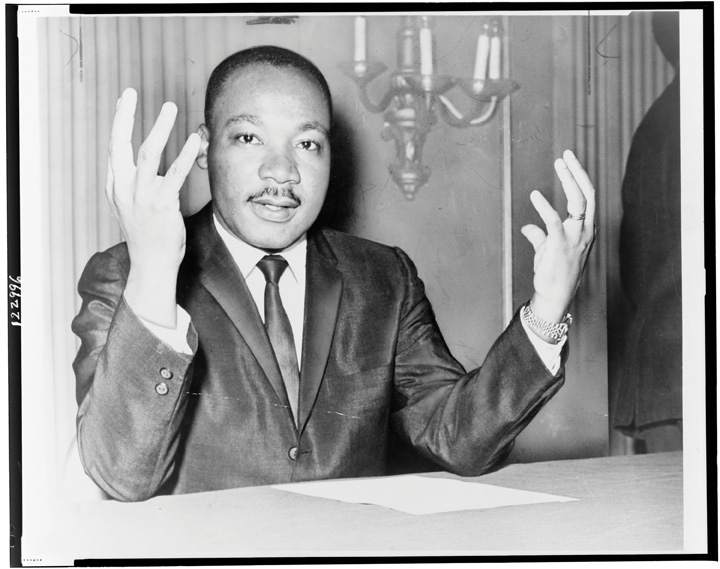
Weber emphasized that charismatic authority in its pure form (i.e., when authority resides in someone solely because of the person’s charisma and not because the person also has traditional or rational-legal authority) is less stable than traditional authority or rational-legal authority. The reason for this is simple: once charismatic leaders die, their authority dies as well. Although a charismatic leader’s example may continue to inspire people long after the leader dies, it is difficult for another leader to come along and command people’s devotion as intensely. After the deaths of all the charismatic leaders named in the preceding paragraph, no one came close to replacing them in the hearts and minds of their followers.
Because charismatic leaders recognize that their eventual death may well undermine the nation or cause they represent, they often designate a replacement leader, who they hope will also have charismatic qualities. This new leader may be a grown child of the charismatic leader or someone else the leader knows and trusts. The danger, of course, is that any new leaders will lack sufficient charisma to have their authority accepted by the followers of the original charismatic leader. For this reason, Weber recognized that charismatic authority ultimately becomes more stable when it is evolves into traditional or rational-legal authority. Transformation into traditional authority can happen when charismatic leaders’ authority becomes accepted as residing in their bloodlines, so that their authority passes to their children and then to their grandchildren. Transformation into rational-legal authority occurs when a society ruled by a charismatic leader develops the rules and bureaucratic structures that we associate with a government. Weber used the term routinization of charisma to refer to the transformation of charismatic authority in either of these ways.
Types of Government
Various states and governments obviously exist around the world. In this context, state means the political unit within which power and authority reside. This unit can be a whole nation or a subdivision within a nation. Thus the nations of the world are sometimes referred to as states (or nation-states), as are subdivisions within a nation, such as California, New York, and Texas in the United States.Government means the group of persons who direct the political affairs of a state, but it can also mean the type of rule by which a state is run. Another term for this second meaning of government ispolitical system, which we will use here along with government. The type of government under which people live has fundamental implications for their freedom, their welfare, and even their lives. Accordingly we briefly review the major political systems in the world today.

Most people generally agree that anarchy, or the absence of organized government, does not facilitate a desirable living environment for society, but it is much harder for individuals to agree upon the particulars of how a population should be governed. Throughout history, various forms of government have evolved to suit the needs of changing populations and mindsets, each with pros and cons. Today, members of Western society hold that democracy is the most just and stable form of government, although former British Prime Minister Winston Churchill once declared to the House of Commons, “Indeed it has been said that democracy is the worst form of government except for all those other forms that have been tried from time to time” (Shapiro 2006)
Democracy
The type of government with which we are most familiar is democracy, or a political system in which citizens govern themselves either directly or indirectly. The term democracy comes from Greek and means “rule of the people.” In Lincoln’s stirring words from the Gettysburg Address, democracy is “government of the people, by the people, for the people.” In direct (or pure) democracies, people make their own decisions about the policies and distribution of resources that affect them directly. An example of such a democracy in action is the New England town meeting, where the residents of a town meet once a year and vote on budgetary and other matters. However, such direct democracies are impractical when the number of people gets beyond a few hundred. Representative democracies are thus much more common. In these types of democracies, people elect officials to represent them in legislative votes on matters affecting the population.
Representative democracy is more practical than direct democracy in a society of any significant size, but political scientists cite another advantage of representative democracy. At least in theory, it ensures that the individuals who govern a society and in other ways help a society function are the individuals who have the appropriate talents, skills, and knowledge to do so. In this way of thinking, the masses of people are, overall, too uninformed, too uneducated, and too uninterested to run a society themselves. Representative democracy thus allows for “the cream to rise to the top” so that the people who actually govern a society are the most qualified to perform this essential task (Seward, 2010).Seward, M. (2010). The representative claim. New York, NY: Oxford University Press. Although this argument has much merit, it is also true that many of the individuals who do get elected to office turn out to be ineffective and/or corrupt. Regardless of our political orientations, Americans can think of many politicians to whom these labels apply, from presidents down to local officials. In relation to political lobbying, elected officials may also be unduly influenced by campaign contributions from corporations and other special-interest groups. To the extent this influence occurs, representative democracy falls short of the ideals proclaimed by political theorists.
The defining feature of representative democracy is voting in elections. When the United States was established more than 230 years ago, most of the world’s governments were monarchies or other authoritarian regimes. Like the colonists, people in these nations chafed under arbitrary power. The example of the American Revolution and the stirring words of its Declaration of Independence helped inspire the French Revolution of 1789 and other revolutions since, as people around the world have died in order to win the right to vote and to have political freedom.
Democracies are certainly not perfect. Their decision-making process can be quite slow and inefficient; as just mentioned, decisions may be made for special interests and not “for the people”; and, as we have seen in earlier chapters, pervasive inequalities of social class, race and ethnicity, gender, and age can exist. Moreover, in not all democracies have all people enjoyed the right to vote. In the United States, for example, African Americans could not vote until after the Civil War, with the passage of the 15th Amendment in 1870, and women did not win the right to vote until 1920, with the passage of the 19th Amendment.
Although the United States champions the democratic ideology, it is not a “pure” democracy. In a purely democratic society, all citizens would vote on all proposed legislation, and this is not how laws are passed in the United States. There is a practical reason for this: a pure democracy would be hard to implement. Thus, the United States is a constitution-based federal republic in which citizens elect representatives to make policy decisions on their behalf. The term representative democracy, which is virtually synonymous with republic, can also be used to describe a government in which citizens elect representatives to promote policies that favor their interests. In the United States, representatives are elected at local and state levels, and the votes of the Electoral College determine who will hold the office of president. Each of the three branches of the United States government—the executive, judicial, and legislative—is held in check by the other branches.
In addition to generally enjoying the right to vote, people in democracies also have more freedom than those in other types of governments. Figure 13.2.5 "Freedom Around the World (Based on Extent of Political Rights and Civil Liberties)" depicts the nations of the world according to the extent of their political rights and civil liberties. The freest nations are found in North America, Western Europe, and certain other parts of the world, while the least free lie in Asia, the Middle East, and Africa.
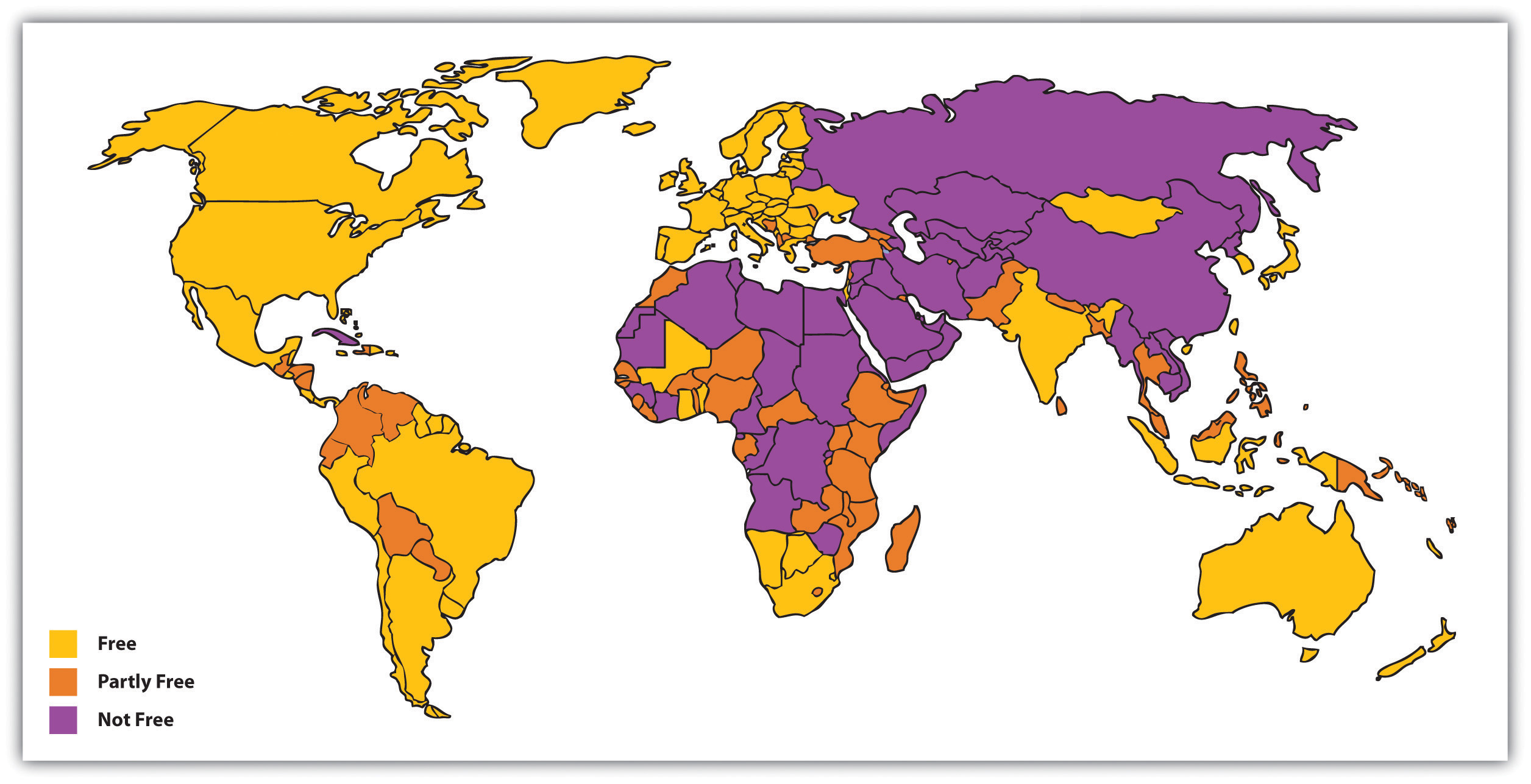
Monarchy
Monarchy is a political system in which power resides in a single family that rules from one generation to the next generation. The power the family enjoys is traditional authority, and many monarchs command respect because their subjects bestow this type of authority on them. Other monarchs, however, have ensured respect through arbitrary power and even terror. Royal families still rule today, but their power has declined from centuries ago. Today the Queen of England holds a largely ceremonial position, but her predecessors on the throne wielded much more power.
Even though people in the United States tend to be most aware of Great Britain’s royals, many other nations also recognize kings, queens, princes, princesses, and other figures with official royal titles. From one country to another, the power held by these positions varies. Strictly speaking, a monarchy is a government in which a single person (a monarch) rules until that individual dies or abdicates the throne. Usually, a monarch claims the rights to title by way of hereditary succession or as a result of some sort of divine appointment or calling. As mentioned previously, the monarchies of most modern nations are ceremonial remnants of tradition, and individuals who hold titles in such sovereignties are often aristocratic figureheads.
This example reflects a historical change in types of monarchies from absolute monarchies to constitutional monarchies (Finer, 1997).Finer, S. E. (1997). The history of government from the earliest times. New York, NY: Oxford University Press. In absolute monarchies, the royal family claims a divine right to rule and exercises considerable power over their kingdom. Absolute monarchies were common in both ancient (e.g., Egypt) and medieval (e.g., England and China) times. In reality, the power of many absolute monarchs was not totally absolute, as kings and queens had to keep in mind the needs and desires of other powerful parties, including the clergy and nobility. Over time, absolute monarchies gave way to constitutional monarchies. In these monarchies, the royal family serves a symbolic and ceremonial role and enjoys little, if any, real power. Instead the executive and legislative branches of government—the prime minister and parliament in several nations—run the government, even if the royal family continues to command admiration and respect. Constitutional monarchies exist today in several nations, including Denmark, Great Britain, Norway, Spain, and Sweden.

In today’s global political climate, monarchies far more often take the form of constitutional monarchies, governments of nations that recognize monarchs but require these figures to abide by the laws of a greater constitution. Many countries that are now constitutional monarchies evolved from governments that were once considered absolute monarchies. In most cases, constitutional monarchies, such as Great Britain and Canada, feature elected prime ministers whose leadership role is far more involved and significant than that of its titled monarchs. In spite of their limited authority, monarchs endure in such governments because people enjoy their ceremonial significance and the pageantry of their rites.

Oligarchy
The power in an oligarchy is held by a small, elite group. Unlike in a monarchy, members of an oligarchy do not necessarily achieve their status based on ties to noble ancestry. Rather, they may ascend to positions of power because of military might, economic power, or similar circumstances.
The concept of oligarchy is somewhat elusive; rarely does a society openly define itself as an oligarchy. Generally, the word carries negative connotations and conjures notions of a corrupt group whose members make unfair policy decisions in order to maintain their privileged positions. Many modern nations that claim to be democracies are really oligarchies. In fact, some prominent journalists have labeled the United States an oligarchy, pointing to the influence of large corporations and Wall Street executives on American policy (Krugman 2011). Other political analysts assert that all democracies are really just “elected oligarchies,” or systems in which citizens must vote for an individual who is part of a pool of candidates who come from the society’s elite ruling class (Winters 2011).
Oligarchies have existed throughout history, and today many consider Russia an example of oligarchic political structure. After the fall of communism, groups of business owners captured control of this nation’s natural resources and have used the opportunity to expand their wealth and political influence. Once an oligarchic power structure is established, it can be very difficult for middle- and lower-class citizens to advance their socioeconomic status.
Authoritarianism Systems of Government
Authoritarianism and totalitarianism are general terms for nondemocratic political systems ruled by an individual or a group of individuals who are not freely elected by their populations and who often exercise arbitrary power. To be more specific, authoritarianism refers to political systems in which an individual or a group of individuals holds power, restricts or prohibits popular participation in governance, and represses dissent. Totalitarianism refers to political systems that include all the features of authoritarianism but are even more repressive as they try to regulate and control all aspects of citizens’ lives and fortunes. People can be imprisoned for deviating from acceptable practices or may even be killed if they dissent in the mildest of ways. The purple nations in Figure 13.2.5 "Freedom Around the World (Based on Extent of Political Rights and Civil Liberties)" are mostly totalitarian regimes, and the orange ones are authoritarian regimes.
Dictatorship
Power in a dictatorship is held by a single person (or a very small group) that wields complete and absolute authority over a government or populace after the dictator rises to power, usually through economic or military might. Similar to many absolute monarchies, dictatorships may often be corrupt and seek to limit and even eradicate the liberties of the general population. Many dictators start out as military leaders and are more conditioned to violence if they face opposition than non-military figureheads.
Dictators use a variety of means to perpetuate their authority. Intimidation and brutality are often foremost among their tactics; individuals are not likely to rebel against a regime if they know they will be hurt. Some dictators also possess the personal appeal that Max Weber identified with a charismatic leader. Subjects of such a dictator may believe that the leader has special ability or authority and may be willing to submit to his or her authority. Popular images of the late Kim Jong-Il, as well as his successor, Kim Jong-Un, exemplify this type of charismatic dictatorship.
Many dictatorships do not align themselves strictly with any particular belief system or ideology; the goal of this type of regime is usually limited to preserving the authority of the dictator at its helm. The totalitarian dictatorship describes a more ambitious and oppressive style of dictatorship that attempts to control all aspects of its subjects’ lives. Communist regimes, for instance, are often totalitarian in nature. They may attempt to regulate how many children citizens bear, what religious beliefs they hold, and so forth. They may also demand that citizens publicly demonstrate their faith in the regime by participating in public marches and demonstrations.
Some “benevolent” dictators, such as Napoleon and Anwar Sadat, are credited with advancing their people or exercising a modest level of evenhandedness, but many end up grossly abusing their power. Joseph Stalin, Adolf Hitler, Kim Jong-Il, Saddam Hussein, and Zimbabwe’s Robert Mugabe, for instance, are heads of state who earned a reputation for leading through fear and intimidation. Hitler, for example, is responsible for the genocide of millions of Jews and other groups, while Mugabe has been accused of ruthless land acquisition.

Absolute Monarchy
A few nations today, however, are run by governments wherein a monarch has absolute or unmitigated power. Such nations are called absolute monarchies. Although governments and regimes are constantly changing across the global landscape, it is generally safe to say that most modern absolute monarchies are concentrated in the Middle East and Africa. The small, oil-rich nation of Oman, for instance, is an example of an absolute monarchy. In this nation, Sultan Qaboos bin Said Al Said has ruled since the 1970's. Recently, living conditions and opportunities for Oman’s citizens have improved, but many citizens who live under the reign of an absolute ruler must contend with oppressive or unfair policies that are installed based on the unchecked whims or political agendas of that leader.


Compared to democracies and monarchies, authoritarian and totalitarian governments are more unstable politically. The major reason for this is that these governments enjoy no legitimate authority. Instead their power rests on fear and repression. The populations of these governments do not willingly lend their obedience to their leaders and realize that their leaders are treating them very poorly; for both these reasons, they are more likely than populations in democratic states to want to rebel. Sometimes they do rebel, and if the rebellion becomes sufficiently massive and widespread, a revolution occurs. In contrast, populations in democratic states usually perceive that they are treated more or less fairly and, further, that they can change things they do not like through the electoral process. Seeing no need for revolution, they do not revolt.
Since World War II, which helped make the United States an international power, the United States has opposed some authoritarian and totalitarian regimes while supporting others. The Cold War pitted the United States and its allies against Communist nations, primarily the Soviet Union, China, Cuba, and North Korea. But at the same time the United States opposed these authoritarian governments, it supported many others, including those in Chile, Guatemala, and South Vietnam, that repressed and even murdered their own citizens who dared to engage in the kind of dissent constitutionally protected in the United States (Sullivan, 2008).Sullivan, M. (2008). American adventurism abroad: Invasions, interventions, and regime changes since World War II (Rev. and expanded ed.). Malden, MA: Blackwell.
Earlier in U.S. history, the federal and state governments repressed dissent by passing legislation that prohibited criticism of World War I and then by imprisoning citizens who criticized that war (Goldstein, 2001).Goldstein, R. J. (2001). Political repression in modern America from 1870 to 1976 (Rev. ed.). Urbana: University of Illinois Press. During the 1960s and 1970s, the FBI, the CIA, and other federal agencies spied on tens of thousands of citizens who engaged in dissent protected by the First Amendment (Cunningham, 2004).Cunningham, D. (2004). There’s something happening here: The new left, the Klan, and FBI counterintelligence. Berkeley: University of California Press. While the United States remains a beacon of freedom and hope to much of the world’s peoples, its own support for repression in the recent and more distant past suggests that eternal vigilance is needed to ensure that “liberty and justice for all” is not just an empty slogan.
The Political System in the United States
In describing a nation’s politics, it’s important to define the term. Some associate “politics” with power, others with freedom. Some with corruption, others with rhetoric. How do sociologists understand politics? To sociologists, politics is a means of studying a nation or group’s underlying social norms and values. A group’s political structure and practices provide insight into its distribution of power and wealth, as well as its larger philosophical and cultural beliefs. A cursory sociological analysis of U.S. politics might, for instance, suggest that Americans’ desire to promote equality and democracy on a theoretical level is at odds with the nation’s real-life capitalist orientation.
The famous phrase “by the people, for the people” is at the heart of American politics and sums up the most essential part of this nation’s political system: the notion that citizens willingly and freely elect representatives they believe will look out for their interests. Although many Americans take for granted the right of citizens to hold free elections, it is a vital foundation of any democracy. However, at the time the U.S. government was formed, African Americans and women were denied voting privileges. History details the struggles that each of these minority groups undertook to secure rights that had been granted to their white male counterparts. Nevertheless, their history (and the earlier history of the struggle for American independence from British rule) has failed to inspire some Americans to show up at the polls or even to register to vote.
Naturally, citizens must participate in the democratic process in order for their voices to be heard. Sociologists understand voting to be at the heart of the U.S. political process because it is a fundamental political behavior in a democracy. Problems with the democratic process, which include more than limited voter turnout, require us to more closely examine complex social issues.
Political Ideology and Political Parties
Two central components of modern political systems are (a) the views that people hold of social, economic, and political issues and (b) the political organizations that try to elect candidates to represent those views. We call these components political ideology and political parties, respectively.
Political Ideology
Political ideology is a complex concept that is often summarized by asking people whether they are liberal or conservative. For example, the GSS asks, “I’m going to show you a seven-point scale on which the political views that people might hold are arranged from extremely liberal to extremely conservative. Where would you place yourself on this scale?” For convenience’s sake, responses to this question in the 2008 GSS are grouped into three categories—liberal, moderate, and conservative—and displayed in Figure 13.2.10 "Political Ideology". We see that moderates slightly outnumber conservatives, who in turn outnumber liberals.
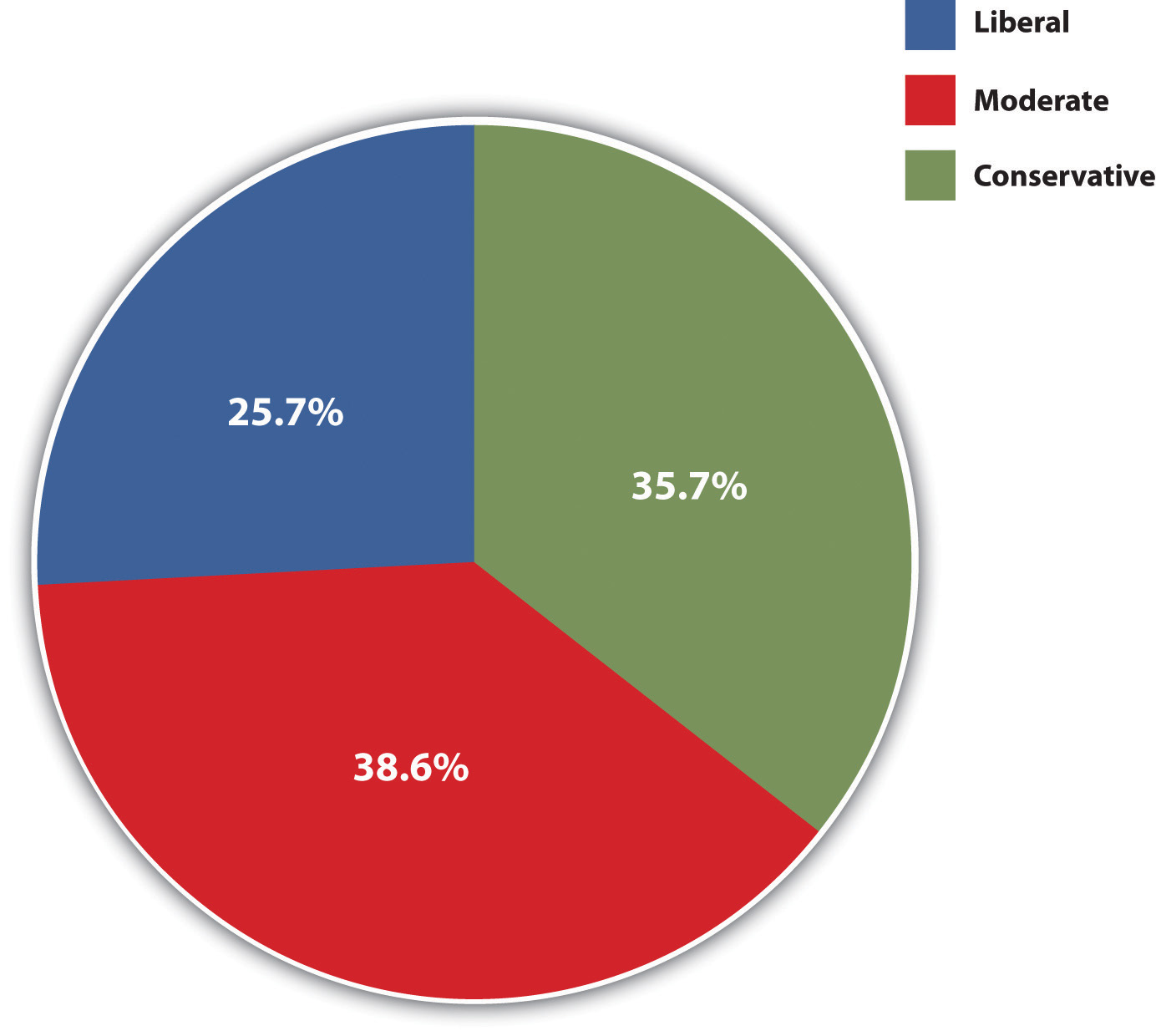
This is a common measure of political ideology, but social scientists often advise using a series of questions to measure political ideology, which consists of views on at least two sorts of issues, social and economic. Social issues concern attitudes on such things as abortion and other controversial behaviors and government spending on various social problems. Economic issues, on the other hand, concern such things as taxes and the distribution of income and wealth. People can hold either liberal or conservative attitudes on both types of issues, but they can also hold mixed attitudes: liberal on social issues and conservative on economic ones, or conservative on social issues and liberal on economic ones. Educated, wealthy people, for example, may want lower taxes (generally considered a conservative view) but also may favor abortion rights and oppose the death penalty (both considered liberal positions). In contrast, less educated, working-class people may favor higher taxes for the rich (a liberal view, perhaps) but oppose abortion rights and favor the death penalty.
We also see mixed political ideologies when we look at African Americans’ and whites’ views on social and economic issues. African Americans tend to be more conservative than whites on social issues but more liberal on economic concerns. This tendency is depicted in Figure 13.2.12 "Race and Attitudes on Social and Economic Issues", which shows responses to GSS questions on whether homosexual sex is wrong, a social issue, and on whether the government should reduce income differences between the rich and poor, an economic issue. African Americans are more likely than whites to take a conservative view on the social issue by thinking that homosexual sex is wrong but are more likely to take a liberal view on the economic issue by thinking that the government should reduce income inequality.
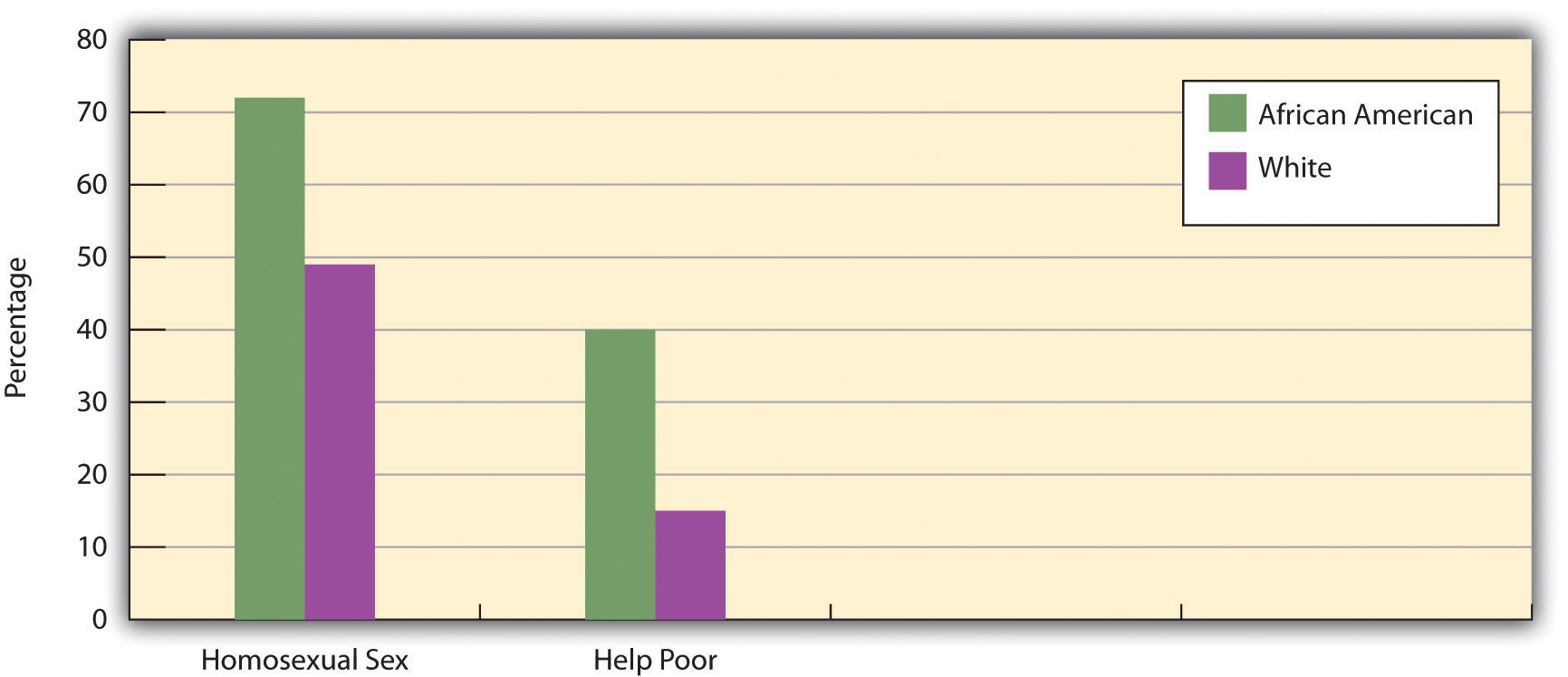
Political Parties
People’s political ideologies often lead them to align with a political party, or an organization that supports particular political positions and tries to elect candidates to office to represent those positions. The two major political parties in the United States are, of course, the Democratic and Republican parties. However, in a national poll in October 2009, 44% of Americans called themselves Independents, compared to 30% who called themselves Democrats and only 17% who called themselves Republicans. The number of Americans who consider themselves Independents, then, almost equals the number who consider themselves either Democrats or Republicans (Rich, 2009).Rich, F. (2009, November 1). The G.O.P. Stalinists invade upstate New York. The New York Times, p. WK8.
An important question for U.S. democracy is how much the Democratic and Republican parties differ on the major issues of the day. The Democratic Party is generally regarded as more liberal, while the Republican Party is regarded as more conservative, and voting records of their members in Congress generally reflect this difference. However, some critics of the U.S. political system think that in the long run there is not a “dime’s worth of difference,” to quote an old saying, between the two parties, as they both ultimately work to preserve corporate interests and capitalism itself (Alexander, 2008).Alexander, S. A. (2008, January 10). Socialists emerging as Democrats, Republicans lose voter confidence. American Chronicle. Retrieved from www.americanchronicle.com/articles/view/48507
In their view, the Democratic Party is part of the problem, as it tries only to reform the system instead of bringing about the far-reaching changes said to be needed to achieve true equality for all. These criticisms notwithstanding, it is true that neither of the major U.S. parties is as left-leaning as some of the major ones in Western Europe. The two-party system in the United States may encourage middle-of-the road positions, as each party is afraid that straying too far from the middle will cost it votes. In contrast, because several Western European nations have a greater number of political parties, a party may feel freer to advocate more polarized political views (Muddle, 2007).Muddle, C. (2007). Populist radical right parties in Europe. New York, NY: Cambridge University Press.
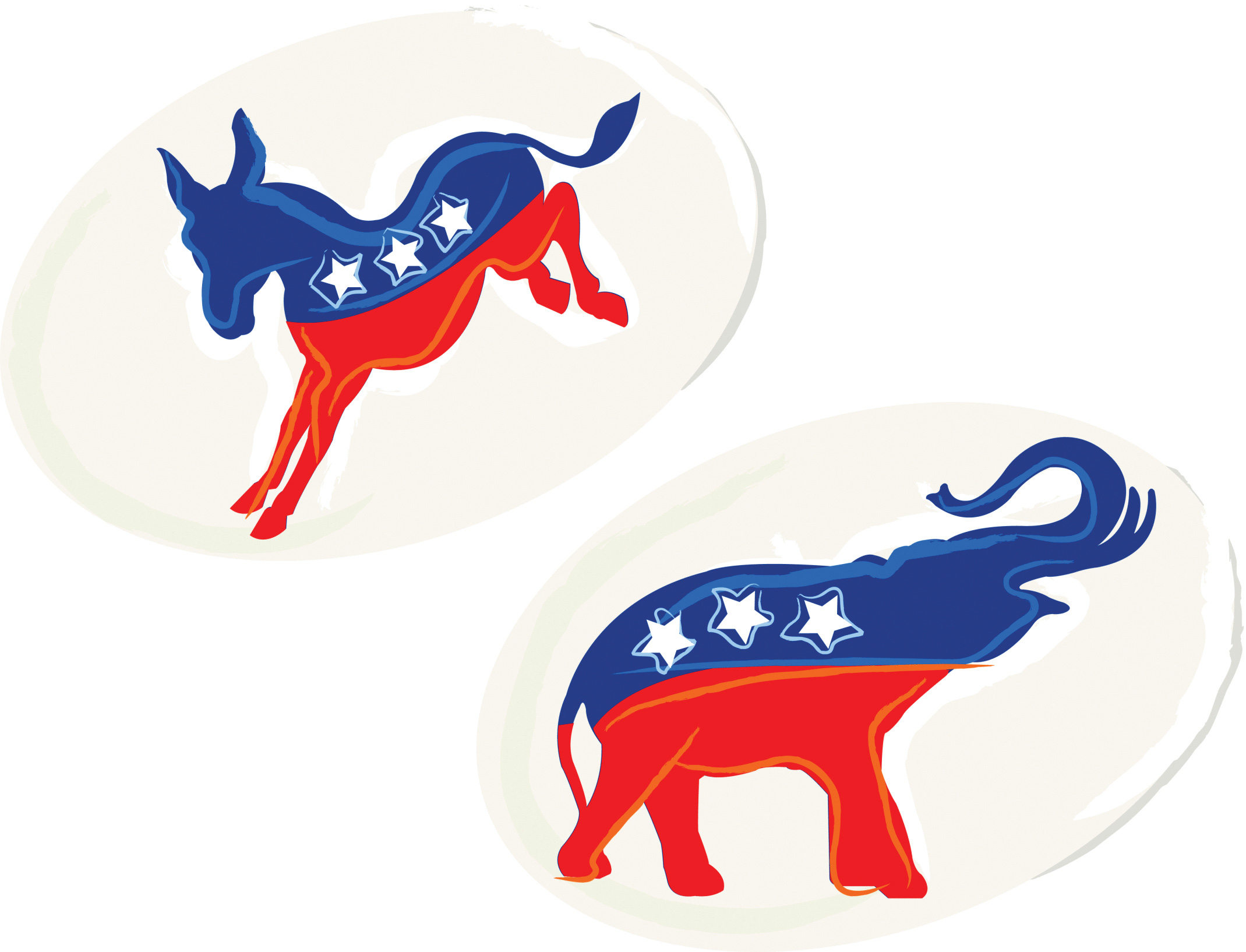
Some scholars see this encouragement of middle-of-the-road positions (and thus political stability) as a benefit of the U.S. two-party system, while other scholars view it as a disadvantage because it limits the airing of views that might help a nation by challenging the status quo (Richard, 2010).Richard, J. (2010, May 29). One cheer for the two-party system. OpEdNews.
Retrieved from http://www.opednews.com/articles/One-Cheer-for-the-Two-Part-by-Jerome-Richard-100527-100148.html
One thing is clear: in the U.S. two-party model, it is very difficult for a third party to make significant inroads, because the United States lacks a proportional representation system, found in many other democracies, in which parties win seats proportional to their share of the vote (Disch, 2002).Disch, L. J. (2002). The tyranny of the two-party system. New York, NY: Columbia University Press. Instead, the United States has a winner-takes-all system in which seats go to the candidates with the most votes. Even though the Green Party has several million supporters across the country, for example, its influence on national policy has been minimal, although it has had more influence in a few local elections.
Whether or not the Democratic and Republican parties are that different, U.S. citizens certainly base their party preference in part on their own political ideology. Evidence of this is seen in Figure 13.2.15 "Political Ideology and Political Party Preference", which shows the political ideology of GSS respondents who call themselves Democrats or Republicans. People’s political ideology is clearly linked to their party preference.
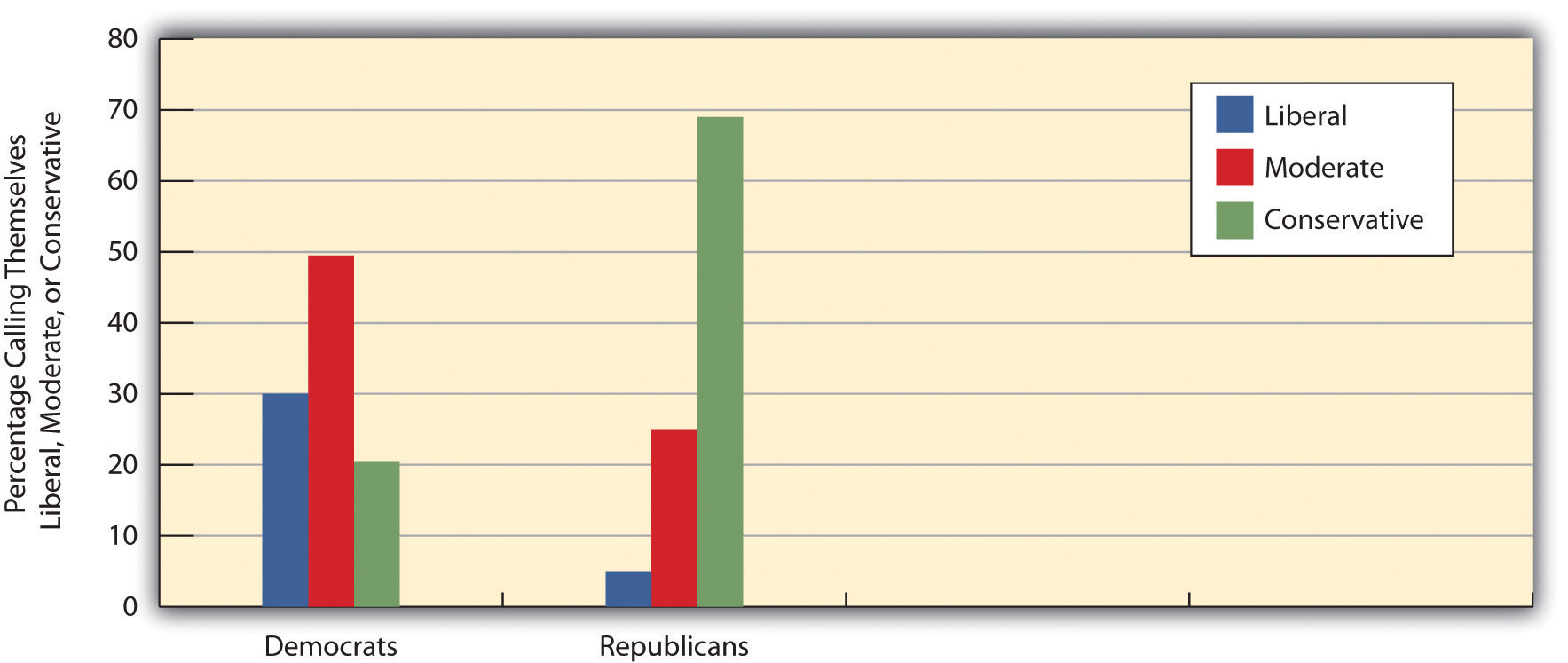
Political Participation
Perhaps the most important feature of representative democracies is that people vote for officials to represent their views, interests, and needs. For a democracy to flourish, political theorists say, it is essential that “regular” people participate in the political process. The most common type of political participation, of course, is voting; other political activities include campaigning for a candidate, giving money to a candidate or political party, and writing letters to political officials. Despite the importance of these activities in a democratic society, not very many people take part in them. Voting is also relatively uncommon among Americans, as the United States ranks lower than most of the world’s democracies in voter turnout (International Institute for Democracy and Electoral Assistance, 2009).International Institute for Democracy and Electoral Assistance. (2009). Voter turnout.
Retrieved from www.idea.int/vt/index.cfm
Not only is U.S. voter turnout relatively low in the international sphere, but it has also declined since the 1960s (see Figure 13.2.16 "Trends in Voter Turnout in Non-presidential Election Years"). One factor that explains these related trends is voter apathy, prompted by a lack of faith that voting makes any difference and that government can be helpful. This lack of faith is often called political alienation. As Figure 13.2.17 "Trust in U.S. Government" dramatically shows, lack of faith in the government has dropped drastically since the 1960's, thanks in part, no doubt, to the Vietnam War during the 1960's and 1970's and the Watergate scandal of 1970's.
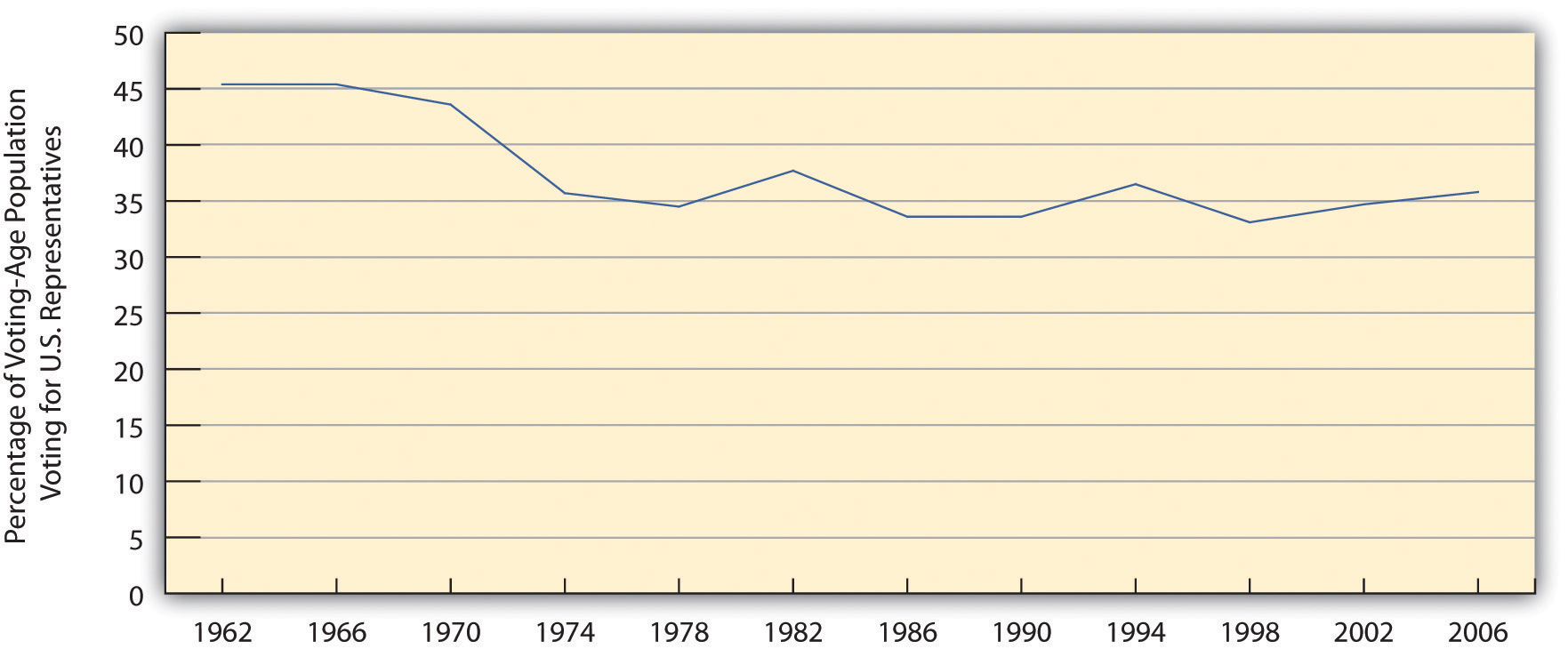
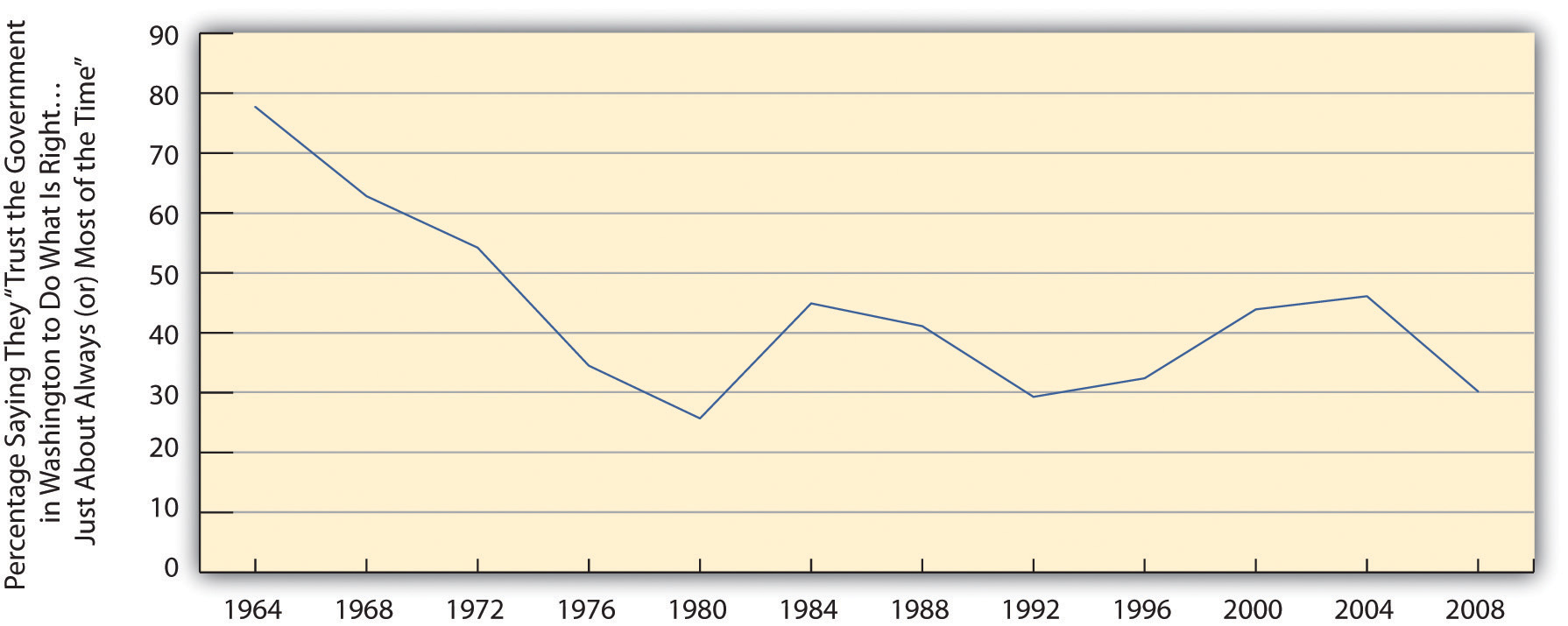
Yet it is also true that voter turnout varies greatly among Americans. In general, several sets of factors make citizens more likely to vote and otherwise participate in the political process (Burns, Schlozman, & Verba, 2001).Burns, N., Schlozman, K. L., & Verba, S. (2001). The private roots of public action: Gender, equality, and political participation. Cambridge, MA: Harvard University Press. These factors, or correlates of political participation, include (a) high levels of resources, including time, money, and communication skills; (b) psychological engagement in politics, including a strong interest in politics and a sense of trust in the political process; and (c) involvement in interpersonal networks of voluntary and other organizations that recruit individuals into political activity. Thus people who are, for example, wealthier, more interested in politics, and more involved in interpersonal networks are more likely to vote and take part in other political activities than those who are poorer, less interested in politics, and less involved in interpersonal networks. Reflecting these factors, age and high socioeconomic status are especially important predictors of voting and other forms of political participation, as citizens who are older, wealthier, and more educated tend to have more resources, to be more interested in politics and more trustful of the political process, and to be more involved in interpersonal networks. As a result, they are much more likely to vote than people who are younger and less educated (see Figure 13.2.18 "Age, Education, and Percentage Voting, 2008").
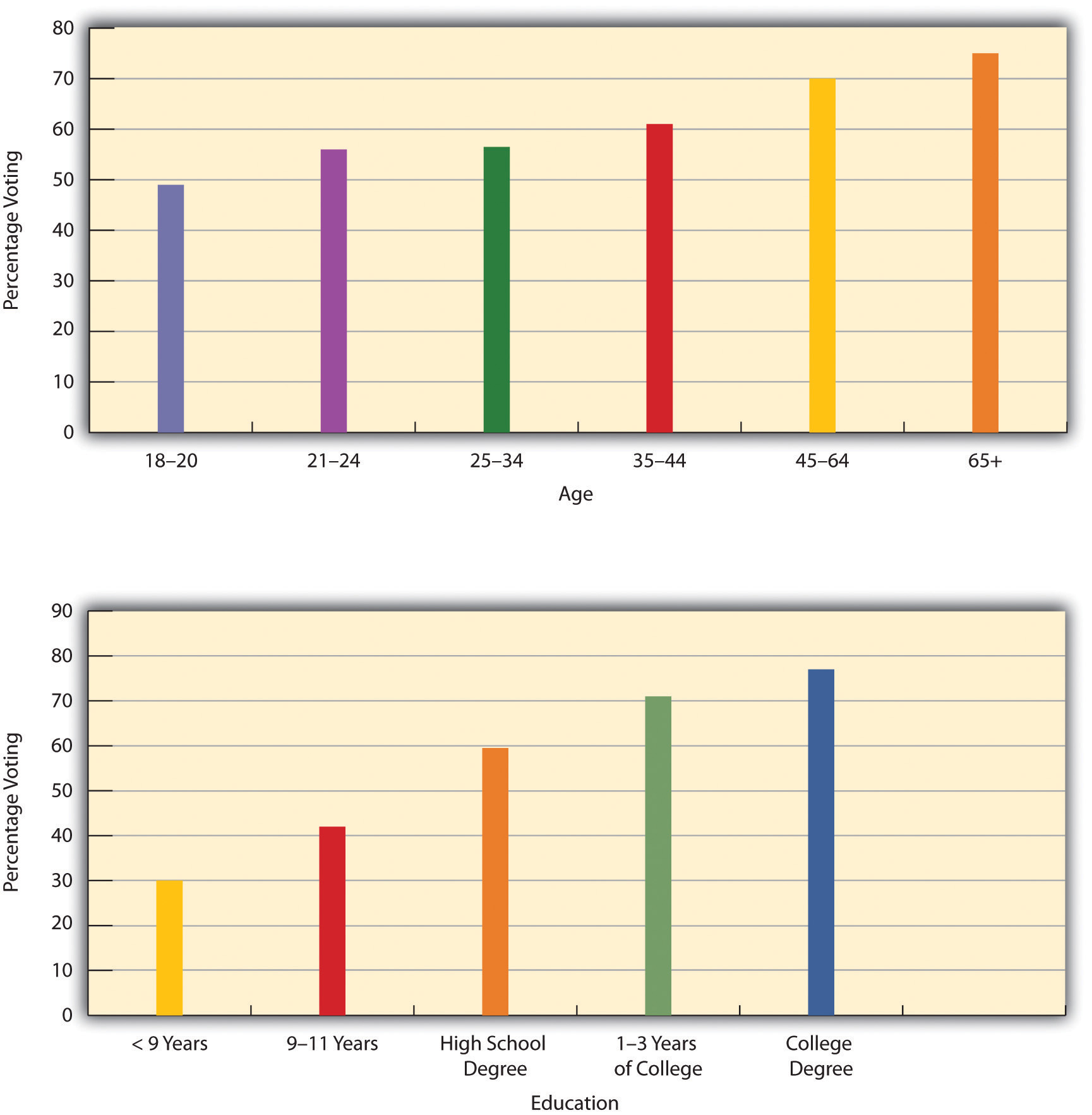
The lower voting rates for young people might surprise many readers: because many college students are politically active, it seems obvious that they should vote at high levels. That might be true for some college students, but the bulk of college students are normally not politically active, because they are too busy with their studies, extracurricular activities, and/or work, and because they lack sufficient interest in politics to be active. It is also true that there are many more people aged 18 to 24 (about 30 million), the traditional ages for college attendance, than there are actual college students (11 million). In view of these facts, the lower voting rates for young people are not that surprising after all.
Race and ethnicity also influence voting. In particular, Asians and Latinos vote less often than African Americans and whites among the citizen population. In 2008, roughly 65% of African Americans and 66% of non-Latino whites voted, compared to only 48% of Asians and 50% of Latinos (File & Cressey, 2010).File, T., & Cressey, S. (2010). Voting and registration in the election of 2008 (Current Population Report P20-562). Washington, DC: U.S. Census Bureau. The voting percentage for African Americans and Latinos was the highest for these groups since the Census Bureau began measuring citizens’ voting in 1996, possibly because of the presence of Barack Obama, who considers himself an African American, on the Democratic ticket.
The impact of age, race/ethnicity, education, and other variables on voting rates provides yet another example of the sociological perspective. As should be evident, they show that these aspects of our social backgrounds affect a very important political behavior, voting, even if we are not conscious of this effect.

Special-Interest Groups and Lobbying: The Influence Industry
From 2003 through 2008, political action committees (PACs), organizations formed by special-interest groups to raise and spend money on behalf of political campaigns and various political issues, contributed more than $1 billion to the election campaigns of candidates for Congress (U.S. Census Bureau, 2010).U.S. Census Bureau. (2010). Statistical abstract of the United States: 2010. Washington, DC: U.S. Government Printing Office. Retrieved from www.census.gov/compendia/statab In 2008 and 2009, special-interest groups spent more than $6.3 billion to lobby Congress, the White House, and various federal agencies. They employed some 14,000 lobbyists, who outnumbered members of Congress 27 to 1, on such issues as health care, military spending, and transportation (Center for Responsive Politics, 2009).Center for Responsive Politics. (2009). Lobbying database.
Retrieved from www.opensecrets.org/lobbyists
The top lobbying group in 2009 was the U.S. Chamber of Commerce, which spent more than $65 million to lobby Congress, federal agencies, and other parties; in second place was Exxon Mobil, which spent more than $21 million. The pharmaceutical and health products industry as a whole spent more than $200 million in 2009, while the insurance industry spent $122 million, oil and gas companies $121 million, electric and gas utilities $108 million, and business associations $93 million.
Dubbed the “influence industry,” these lobbying efforts have long been criticized as having too much impact on federal policy and spending priorities. It is logical to think that the influence industry spends these large sums of money because it hopes to affect key legislation and other policies. This expenditure raises an important question: are PACs, special-interest groups, and lobbying good or bad for democracy? This question goes to the heart of the debate between pluralist and elite theories, discussed earlier.
Representatives of PACs and lobbying groups say it is important that elected officials hear all possible views on complex issues and that these organizations merely give money to help candidates who already think a certain way. Supporting this notion, public officials say they listen to all sides before making up their minds and are not unduly influenced by the money they receive and by the lobbying they encounter. For their part, pluralist theorists say PACs and lobbying groups are examples of the competing veto groups favored by the pluralist model and that no one special-interest group wins out in the long run (James, 2004).James, M. R. (2004). Deliberative democracy and the plural polity. Lawrence: University Press of Kansas.
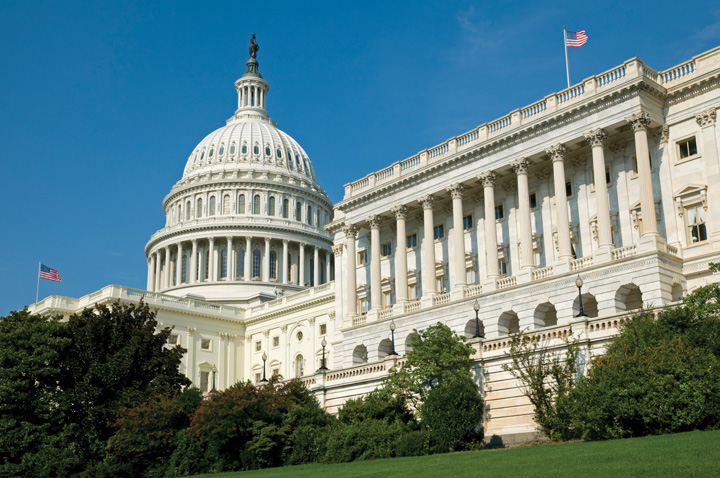
Critics of the influence industry say that its impact is both large and unwarranted and charge that PACs, lobbyists, and the special-interest groups that fund them are buying influence and subverting democracy. Ample evidence exists, they say, of the impact of the influence industry on which candidates get elected and on which legislation gets passed or not passed. While special-interest groups for various sides of an issue do compete with each other, they continue, corporations and their PACs are much better funded and much more influential than the groups that oppose them (Clawson, Neustadtl, & Weller, 1998; Cook & Chaddock, 2009).Clawson, D., Neustadtl, A., & Weller, M. (1998). Dollars and votes: How business campaign contributions subvert democracy. Philadelphia, PA: Temple University Press; Cook, D. T., & Chaddock, G. R. (2009, September 28). How Washington lobbyists peddle power. The Christian Science Monitor. Retrieved from http://www.csmonitor.com/USA/Politics/2009/0928/how-washington-lobbyists-peddle-power
These concerns motivated sharp criticism of a U.S. Supreme Court decision in January 2010 regarding election advertisements by corporations and unions. The decision permitted corporations and unions to use money from their general funds to pay for ads urging the public to vote for or against a particular candidate. Because corporations have much more money than unions, the ruling was widely seen as being a procorporation one. The majority decision said that prohibitions of such advertising violated freedom of political speech by corporations and unions, while the minority decision said the ruling “threatens to undermine the integrity of elected institutions across the nation” (Vogel, 2010).Vogel, K. P. (2010, January 21). Court decision opens floodgates for corporate cash. Politico.
Retrieved from http://www.politico.com/news/stories/0110/31786.html
Key Takeaways
- Political ideology consists of views on social issues and on economic issues. An individual might be liberal or conservative on both kinds of issues, or liberal on one kind of issue and conservative on the other kind.
- Almost as many Americans consider themselves Independents as consider themselves either Democrats or Republicans. Although some scholars say that there is not very much difference between the Democratic and Republican parties, liberals are more likely to consider themselves Democrats, and conservatives are more likely to consider themselves Republicans.
- Voting is the most common form of political participation. Several factors influence the likelihood of voting, and socioeconomic status (education and income) is a very important factor in this regard.
- Political lobbying remains a very controversial issue, and critics continue to charge that the “influence industry” has too much sway over American social and economic policy.

